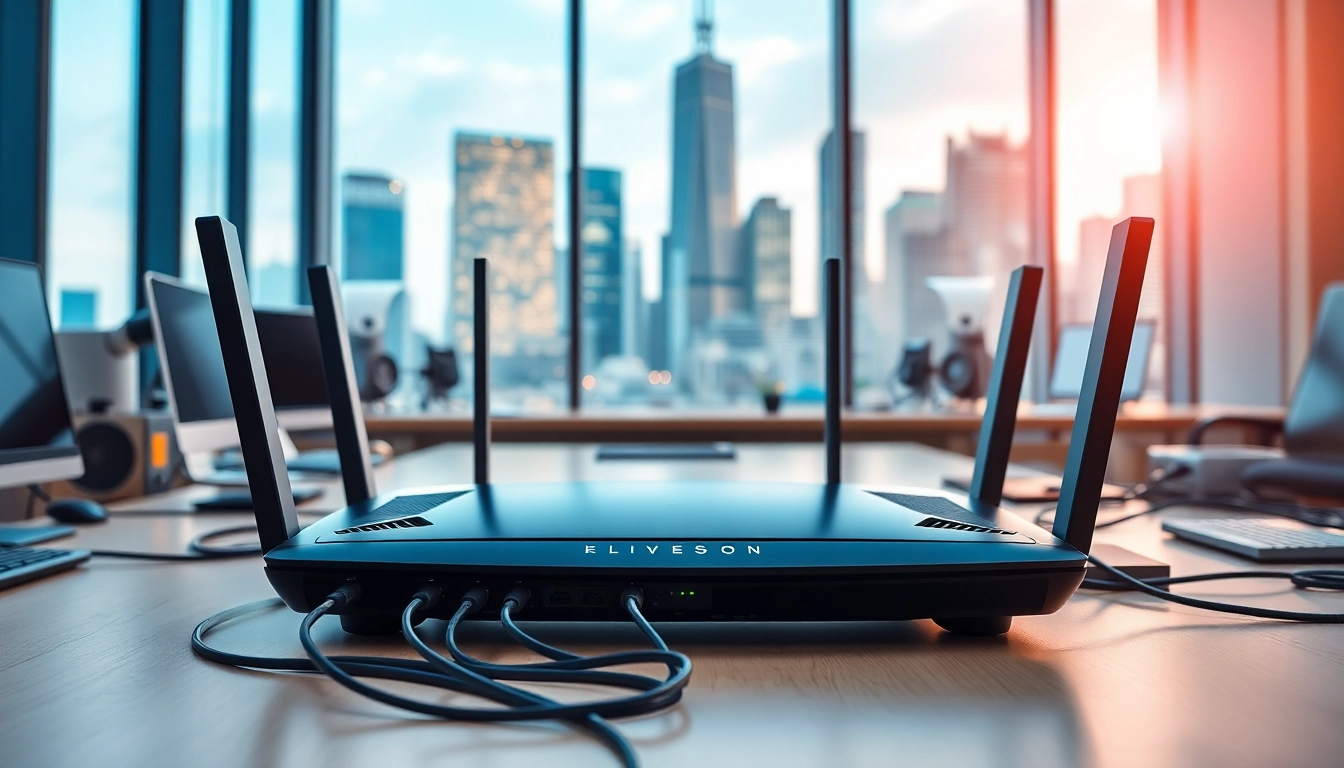Understanding the 5G Router Technology
What is a 5G Router?
A 5G Router is a networking device that utilizes the fifth generation of wireless technology to provide high-speed internet connectivity. Unlike traditional routers that operate on earlier networks such as 4G or LTE, 5G Routers leverage the ultra-fast, low-latency capabilities of 5G networks. This means users can experience download speeds surpassing 1 Gbps, drastically enhancing activities such as video streaming, online gaming, and large file downloads.
How 5G Router Works
The operational principle of a 5G Router is rooted in accessing and translating signals from cellular networks to usable internet connections in a home or office environment. The router connects to a nearby 5G cell tower, utilizing millimeter-wave, sub-6 GHz, or a combination of frequencies, effectively converting the wireless signal into a stable internet connection. This process enables multiple devices to connect simultaneously without a degradation of performance.
Major Differences with Previous Technologies
5G Routers offer a paradigm shift compared to their 4G counterparts in several key areas:
- Speed: 5G networks can provide speeds up to 100 times faster than 4G.
- Latency: Reduced latency to as low as 1 millisecond enhances real-time applications like gaming and video conferencing.
- Capacity: 5G networks support more devices per square kilometer, making them ideal for densely populated areas.
- Reliability: Enhanced signal stability, even in challenging environments, provides a consistent internet experience.
Benefits of Using a 5G Router
Increased Speed and Efficiency
With the capabilities of 5G technology, users can enjoy significantly faster internet speeds. This heightened efficiency translates to quick downloads, seamless streaming without buffering, and reduced latency during online interactions. For professional environments where downtime directly affects productivity, these efficiencies provide a tangible competitive edge.
Improved Connectivity Options
A 5G Router enhances connectivity by supporting various wireless technologies. One notable feature is the ability to connect devices with different connectivity standards, which is critical as more smart devices populate homes and offices. Moreover, the extensive coverage can greatly reduce the dependency on wired internet connections, allowing for greater mobility and flexibility in both home and work settings.
Future-Proofing Your Internet Experience
Investing in a 5G Router not only addresses current needs but also prepares users for future technological advancements. As demand for higher bandwidth applications continues to grow—such as augmented reality and virtual reality—5G Routers are designed to accommodate these evolving requirements, ultimately protecting your investment against rapid obsolescence.
Choosing the Right 5G Router
Key Features to Look For
When selecting a 5G Router, consider the following features:
- Speed Capabilities: Look for routers capable of providing maximum throughput for your internet needs.
- Frequency Bands: Dual-band routers can operate on both 2.4 GHz and 5 GHz bands, offering flexibility and optimal performance.
- Number of Ports: Ensure the router has sufficient Ethernet ports to accommodate wired connections.
- Antennas: External antennas can enhance signal strength and coverage, beneficial for larger areas.
- Security Features: Look for routers with robust security protocols to protect sensitive information and devices.
Compatibility with Devices
Before purchasing a 5G Router, it’s essential to verify its compatibility with existing devices. Modern routers typically support a wide range of devices, including smartphones, tablets, laptops, and smart home devices. However, ensure that your devices are 5G capable to take full advantage of the speeds and connectivity features.
Price Considerations
The price of a 5G Router can vary significantly based on features and capabilities. It’s important to balance your budget with the necessary functionalities. While high-end models may offer advanced features like enhanced security and extensive range, mid-range options might meet basic needs for smaller homes or lighter internet usage. Assess your specific requirements to ensure you invest wisely.
Installing and Setting Up Your 5G Router
Step-by-step Installation Guide
Setting up a 5G Router is generally straightforward. Follow these steps to ensure a smooth installation:
- Unbox and Prepare: Carefully unbox your router and check the included components for completeness.
- Placement: Choose a central location for the router to maximize coverage, avoiding obstacles like walls and large furniture.
- Connect Power: Plug the router into a power source and turn it on.
- Connect to the Network: Access the router’s user interface (usually via a web browser) using the default IP address provided in the manual.
- Configure Settings: Follow the on-screen prompts to set up your internet connection, Wi-Fi network name (SSID), and password.
- Connect Devices: Use your wireless devices to connect to the newly created network. For wired connections, use Ethernet cables to connect devices directly to the router.
Troubleshooting Common Setup Issues
During installation, users may encounter some common issues. Here are troubleshooting tips for resolving these challenges:
- No Internet Connection: Ensure all cables are securely connected and reboot the router if necessary. Verify settings in the user interface.
- Weak Signal: Adjust the router’s location to reduce physical obstructions and improve signal strength.
- Device Compatibility: Verify that all connected devices support 5G technology and check their settings if they are not connecting.
Optimizing Performance Post-Installation
To enhance your 5G Router’s performance after installation, consider the following strategies:
- Update Firmware: Regularly check for firmware updates to ensure optimal performance and security.
- Monitor Connected Devices: Limit the number of connected devices to ensure maximum speed for essential tasks.
- Adjust Channel Settings: Switching the Wi-Fi channel can reduce interference from neighboring networks, improving connection stability.
Monitoring and Maintaining Your 5G Router
Best Practices for Maintenance
Maintaining your 5G Router is crucial for long-term performance. Here are some best practices:
- Regular Reboots: Reboot the router periodically to clear cache and improve performance.
- Clean the Device: Dust and dirt can accumulate on routers, impeding performance. Regularly clean the device and ensure proper ventilation.
- Secure Your Network: Change the default login credentials and Wi-Fi password to protect against unauthorized access.
Performance Metrics to Track
Monitoring specific performance metrics can help you gauge your 5G Router’s efficiency. Key metrics include:
- Download and Upload Speeds: Regularly test internet speed to ensure you’re receiving expected performance.
- Latency: Check ping times to assess responsiveness during internet activities.
- Device Load: Monitor the number of connected devices to ensure optimal performance without bandwidth choking.
When to Upgrade Your 5G Router
Knowing when to upgrade your 5G Router is essential for maintaining an efficient internet experience. Signs that an upgrade may be necessary include:
- Consistent Slow Speeds: If your speeds are consistently below expectations despite troubleshooting.
- Frequent Disconnects: Regular dropouts can indicate hardware issues or outdated equipment.
- Incompatibility with New Devices: If you acquire new devices that require more advanced features or speed, it may be time for an upgrade.




